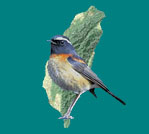|
|
TRIP REPORT: BIRDING IN
TAIWAN,
November (6)7–19, 2006
Leaders:
Simon Liao and Jo
Ann MacKenzie
Text and
photos: Jo Ann MacKenzie
|
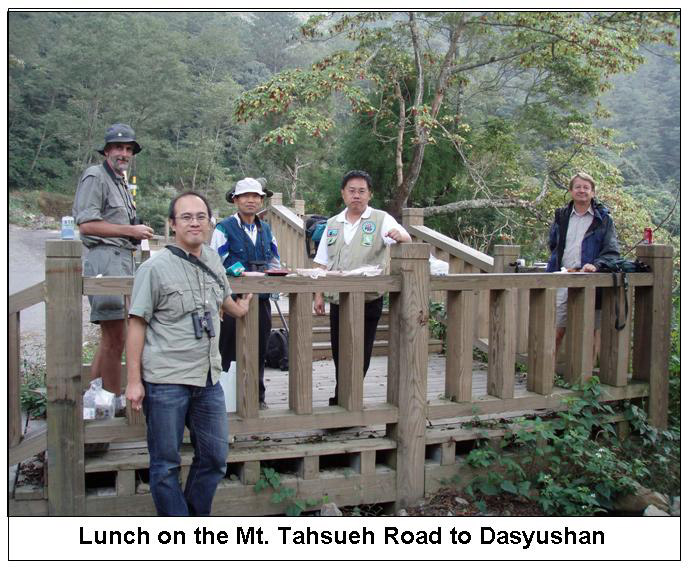 |
Endemic species in BOLD
Taiwan is a mountainous island in the
South China Sea,
about 175 km (110 mi.) off the Chinese mainland. The forested
beauty of the island led Portuguese sailors in 1590 to call it
Ilha Formosa, meaning “Beautiful
Island.” The tropic of Cancer passes through the southern part of
the island.
Participants arrived in Taiwan early, and had a day’s
birding with
Simon Liao
in the Taipei area before the tour formally began. Among the
species seen that day was FORMOSAN MAGPIE in Yangminshan
National Park.
That was the only day that the magpie was seen, therefore it is not
included on the official Trip Results List. Because tour
participants were satisfied with that sighting, the tour itinerary
was adjusted to omit other Formosan Magpie habitat in favour of more
time in higher mountain habitats.
Tuesday, November 7
To Dasyueshan
We started up the Mt. Tahsueh Road to Dasyueshan,
stopping for a leg-stretch now and then, and coming upon Collared
Finchbill, Crested Goshawk and Crested Serpent-Eagle on the way. We
stopped at the observation platform at Km 23.5, where Idesia
polycarpa trees were in fruit. In fall and winter, the trees’
red berries attract many birds. On that day, the Idesia and
other trees held White-eared Sibia, Steere’s Liocichla,
Yellow Tit, Black-throated and Green-backed Tits, Eurasian
Nuthatch, Gray-cheeked Fulvetta, Gray-chinned Minivet and a
transient Mugimaki Flycatcher. An Oriental Honey-Buzzard and 3
White-throated Needletails appeared overhead. Intermittent fog
rising from the valley occasionally made viewing difficult.
Continuing on, we crossed a very steep, precipitous
slope on a new, sturdy, concrete bridge, situated well away from the
crumbling face of the slope, and which replaces the two former roads
that were destroyed by typhoons in 2004 and 2005. Soon after, we
arrived at the Dasyueshan National Forest Recreation Area in the
Anmashan mountain range. Stopping along the road again, we located
Taiwan Barwing, Taiwan Yuhina, and Rusty Laughingthrush.
Making use of the remaining daylight, we went straight to Trail 210
where a Pygmy Wren-Babbler bathed in a puddle on the path;
Collared Bush-Robin, Black-throated Tit, Eurasian Jay were also
seen and White-browed Shortwing was heard. After dark we continued
to the Visitor Center, supper and our cottages.
Wednesday, November 8
Dasyueshan
We were out at first light and walked Trail 210 again,
but no pheasants were found. We drove higher, to Hsiaolaishan (Shiaosyueshan),
2600 m (8,530 ft.), where we found several White-whiskered
Laughingthrush, Golden Parrotbill and a briefly,
out-of-season-singing Taiwan Bush-Warbler skulked
frustratingly along with a Brambling. We had a somewhat
better look at a party of White-throated Needletail overhead.
In the afternoon, we tried Trail 210 again, finding
Scaly Thrush, but still no pheasants.
Thursday, November 9
Dasyueshan to Chingjing
Steere’s Liocichlas began to vocalize at 4 a.m, but we
didn’t have to get up until 5. At 6 we were on the road to
Hsiaolaishan again, watching for the Mikado Pheasants that park
staff told us they often see along that road…but not that day. We
returned to the Visitor Center for breakfast, and spent the rest of
the morning back on Trail 210; the leaders staying behind in hopes
that the smaller group on the trail would have better success with
pheasants. Unfortunately, still none. We would have to try
again, elsewhere.
We left the park. On our way down the mountain, we were
surprised to discover a Siberian Flycatcher, a rare transient in
Taiwan,
perched on a snag.
Between Fengyuan and Dongshih, we stopped at the
Shihgang Dam on the Dajia River (Tachia Hsi), where the river had
become a waterfall after the severe (M7.3) earthquake of
September 21, 1999.
(The earthquake’s epicentre was near the town of
Chichi
in Nantou County.) Great and Little Egrets fed in the river; Plain
Martins flew overhead.
Following lunch in
Taichung,
we drove back into the mountains, on Highway 14 to Chingjing. After
checking into the Chingjing Resort, we headed on up to the Meifeng
area and the Rueiyan River Trail, “Blue Gate 2” section, to look for
pheasants. We found White-bellied Pigeon, Vivid Niltava and heard
White-browed Shortwing and Taiwan Macaque. As the afternoon faded
into twilight, we hoped for pheasants, but were disappointed,
again.
Friday, November 10
Chingjing–Meifeng
After an early “birders’ breakfast”, we returned to the
Rueiyan River Trail, this time the “Blue Gate #1” section. We were
heartened to find fresh tracks of Swinhoe’s Pheasant and the smaller
Taiwan Partridge in the mud. We heard the Partridge calling, but
could not see it. Again, to increase the group’s chances with
pheasants, the leaders withdrew—but the tactic didn’t help.
However, other species seen included
Taiwan
Yuhina, White-eared Sibia,
White-browed Shortwing, Black-throated Tit, Black-browed Barbet
(endemic-to-be), Ashy Wood-Pigeon, Brownish-flanked Bush-Warbler,
and Crested Goshawk overhead. A return to Blue Gate #2 produced 6
Eye-browed Thrushes, but no pheasants.
After lunch, we drove a very rough back road (under
repair) to a different mountain, Beidongyanshan, for another
pheasant search. This time a female Swinhoe’s Pheasant was
glimpsed.
Saturday, November 11
Chingjing to Fushih
We tried the Blue Gate #1 area yet again, finding
Taiwan Yuhina, White-eared Sibia, along the trail;
Black-throated Tit, Spot-breasted Scimitar-Babbler, Ashy
Wood-Pigeon, Fire-breasted Flowerpecker along the road, Mountain
Hawk-Eagle and a small flock of White-throated Needletail overhead.
Giving up on pheasants in this area this time, we drove
higher, to Hehuanshan, just inside the western entrance of Taroko
National Park. During the climb, we were surprised to see that the
highway was infested with motorcycles in a hurry, passing us on both
sides, and taking some life-threatening risks. “What’s this all
about?” we wondered. On reaching the motorcycle-jam-packed parking
area at Wuling (“Big Wind”) at 3275 m (10,750 ft.), we found
out—there was a cycle rally in progress. Hundreds of motorcyclists
had gathered for a brief time, then would rush back down the
mountain. We would not have to contend with them any farther. In
spite of the noise and crowd of people, we found a dozen Alpine
Accentors on the rocks around and below the lookout.
Continuing on, we found a Bronzed Drongo and Winter Wren
below Hohuan Youth Hostel. Flamecrest and Gray-headed
Bullfinch were in the fir and hemlock trees behind the High Altitude
Experimental Station of the Taiwan Endemic Species Research
Institute and the
Visitor
Center at Shiaofongkou (“Little Wind Gap”).
Making several stops, we continued down the east side of
the mountain, finding several Styan’s Bulbuls on the
way. We continued on to Fushih, at the park’s east gate, for the
night.
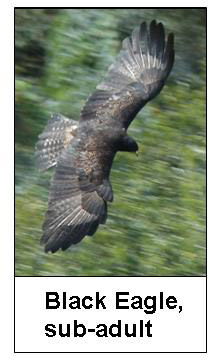 Sunday,
November 12
Fushih toTaitung Sunday,
November 12
Fushih toTaitung
After early morning birding around Fushih (more Styan’s
Bulbuls) and breakfast, we drove south a short distance along the
east coast, then through the East Rift Valley National Scenic Area
to Chihshang. Wind was blowing strongly from the northeast, making
birding in the open, around Big Wave Pond difficult. Ring-necked
Pheasant is an uncommon resident in
Taiwan;
we found 9 in Chihshang farmland. After lunch, we continued to
Taitung.
We were supposed to fly to Lanyu Island in
mid-afternoon, but all 6 daily flights to Lanyu had been cancelled
due to the strong wind. So, we made a visit to Taitung’s excellent
Museum of Pre-history instead. Late afternoon birding in Chihpen
wetland was somewhat hampered by wind, but we did find wintering
party of White-shouldered Starling. We spent the night at the
Aboriginal Culture Hotel, and hoped for better conditions in the
morning.
Monday, November 13
Taitung to Lanyu
Island
We had a productive morning birding along the Lichia
Trail near Chihpen, with superb views of a sub-adult Black Eagle.
We also saw [Taiwan] Hwamei (endemic-to-be), Crested Serpent-Eagle,
Maroon Oriole, Emerald Dove, Chinese Bamboo-Partridge, Yellow-browed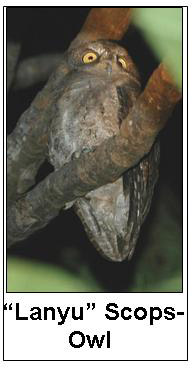 Warbler, and Black-naped Monarch.
Warbler, and Black-naped Monarch.
Back in Taitung, we had lunch at an aboriginal-owned
restaurant, then went to the airport to try to get on a flight to
Lanyu, along with everyone else whose flights had been cancelled
yesterday. We succeeded in making the 3:45 p.m. flight, and 20
minutes later, landed on Lanyu Island. After checking in at the
hotel and picking up our rental van, we drove to “Flycatcher Creek”
where we walked down a rock-strewn dry creek bed in dense forest.
There was a brief glimpse of a Japanese Paradise-Flycatcher in the
dim and failing late afternoon light.
After supper, we went owling for Ryukyu “Lanyu” Scops-Owl,
Otus elegans botelensis, endemic to Lanyu Island. We heard
several and saw two; one just beyond the south edge of the village,
and another in trees among village houses.
Tuesday, November 14
Lanyu Island to
Kending
A pre-breakfast search for Whistling Green-Pigeon failed
to find any. Philippine Cuckoo-Doves were scarce. In the ferry
basin, we spotted a single Horned Grebe, vagrant in winter in
Taiwan; Common Sandpiper, Snowy Plover, 20 Blue Rock-Thrush (19
philippensis and 1 pandoo subspecies; M. s. pandoo
is vagrant), Several Brown-eared Bulbul and Lowland White-eye. Late
morning showers turned to hard rain by noon, and the wind began to
blow again. The
2:40 p.m.
flight back to Taitung was “bumpy.” Rain continued with strong wind
during the drive south to Kenting, where we stayed in the
Kending Youth Activity Center. The attractive complex is built in
the architectural style of Fujian in southern China.
Wednesday, November
15
Kenting to Tainan
The wind blew strongly all night and continued into the
morning. On the way out of town in the early morning, we stopped at
Long Luan Tan (Lake), but the wind interfered with birding. The
rice crop had been harvested, and there was little cover for birds.
Crakes and rails were not to be seen but we did find more Styan’s
Bulbul, Light-vented Bulbul, Purple Heron, and on the lake, Tufted
Duck, Spot-billed Duck and Common Moorhen.
We departed Kending, continuing north and inland. We
drove out of the northeast wind and back into hot, humid
conditions. We could not find the last known pair of Black-naped
Orioles at Inda Eco-Farm, but did find Asian Brown Flycatcher
(uncommon transient), Gray-capped Woodpecker, Pale Thrush, Japanese
Sparrowhawk (another uncommon transient), Gray Treepie, Black kite
and Bronzed Drongo.
After lunch in Chiku, we investigated wetland habitats
in the Tainan-Chiku area, including the Tsengwen River Estuary where
579 Black-faced Spoonbills were wintering. Also there were 2
Saunders’ Gulls, Black-winged Stilt, Eurasian Curlew, Dunlin, and
Sacred Ibis (introduced). Continuing to Cihtao wetland, we found
Cinnamon Bittern, Black-crowned Night-Heron, Garganey, Pacific
Golden and Black-bellied Plover, Little Ringed Plover, Lesser
Sandplover, Common Redshank, Common Greenshank, Marsh Sandpiper,
Wood Sandpiper, Red-necked Stint, and Caspian Tern. Night in
Tainan.
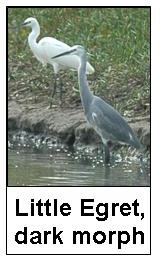 Thursday,
November
16
Tainan
to Alishan Thursday,
November
16
Tainan
to Alishan
In the morning, we drove north to the mouth of the
Pachang River in Chiayi County. A Chinese Crested Tern had been
found there in April, 1998, and we had a faint hope that we might be
lucky enough to find another. We didn’t, but we did find a
dark-morph Little Egret, only the second record for Taiwan. We also
found Yellow Bittern, Black-headed Gull, Eastern Yellow Wagtail and
hundreds of Whiskered Tern.
After lunch in Chiayi, we headed back into the
mountains, to Alishan. We stopped in the Shihchou area on the way,
for Swinhoe’s Pheasant. Arriving at Alishan, we settled into
our comfortable, heated cabins at the Alishan Youth Activity Center,
at 2216 m (7,275 ft.). Rain and darkness prevented any more birding.
Friday, November 17
Alishan
We set out in darkness for Tataka Recreation Area in
Yushan National Park, hoping to find Mikado Pheasant
in the park. Success! A male pheasant fed peacefully along the
roadside and we were able to quietly watch him for several very
satisfying minutes. At the Couple Trees, there was a Dusky Thrush (eunomis
race), Collared Bush-Robin, and Alpine Accentor nearby. We briefly
joined a crowd of non-birders to watch the sunrise, an activity that
brings thousands of tourists to Alishan each year. Reaching Tataka
Recreation Area at 2600 m (8,536 ft.), there was very little bird
activity except for a bold White-whiskered Laughingthrush at
our feet, several Steere’s Liocichla, Streak-throated
Fulvetta, Eurasian Jay, Eurasian Nutcracker, a
White-browed Shortwing and Yellowish-bellied Bush-Warbler.
After lunch at the Tataka Visitor Center (noon
temperature, 15°C; 59°F), we birded our way back toward Alishan and
our cabins. Along the way, we found Brambling, White-eared
Sibia,
Taiwan
Barwing,
Rufous-capped Babbler, Black-throated and Green-backed Tit, and a
large owl that disappeared into the forest before we could identify
it. Two people had a fleeting glimpse of a Eurasian Woodcock, a
rare winterer in
Taiwan.
Saturday, November 18
Alishan to
Changhua
We departed Alishan at 5:30 a.m. and headed down the
mountain to the Shihchou area again. Birds seen along the steep
side road above the village included Taiwan Partridge and
Swinhoe’s Pheasant, Taiwan Yuhina, White-bellied Yuhina,
White-eared Sibia, Black-browed Barbet, White-backed
and Gray-capped Woodpeckers, Black Bulbul, Formosan
Whistling-Thrush, Scaly and Pale Thrushes, Yellow-browed and
Rufous-faced Warbler, Snowy-browed Flycatcher, Mugimaki Flycatcher,
Vivid Niltava, Daurian Redstart, White-tailed Robin, Black-naped
Monarch, Steere’s Liocichla, Black-throated and Green-backed
Tits, Gray Treepie, another glimpsed Eurasian Woodcock, and many
Large-billed Crows. A very successful morning, followed by lunch at
the Firefly in Kwanghua.
After lunch, we continued to the lowlands, reaching the
Changhua area in time for some late afternoon birding in the rice
stubble fields of the Pinheur area (Huatan). We found a small party
of White-cheeked Starlings perched on an overhead wire. Walking
the edges of the fields, through patches of brush and around wet
places, produced Barred Buttonquail, Ruddy-breasted Crake, Greater
Painted-snipe, Common Snipe, Little Ringed Plover, Wood Sandpiper,
Oriental Skylark, White Wagtail, Eastern Yellow Wagtail, Zitting
Cisticola, Brown Shrike, European Starling, Yellow and Black-faced
Bunting (winterers), and many Eurasian Tree Sparrows.
After an ample supper at a Japanese hot pot restaurant,
we retired to the Formosa Hotel.
Sunday, November 19
Taoyuan and
Taipei
We drove north from Changhua to the small city of
Sanchia in south western Taipei County to visit the unique Sanshia
Tsu Sze Temple, popularly known as the “Bird
Temple,” with over a hundred birds carved in wood, in relief on
stone pillars and incised on stone panels. After lunch, we
continued north to Taoyuan International Airport for evening
departures. The rest of the group returned to Taipei to an
exhibition of bird photos by K. K. Kuo. The tour concluded.
- -
- - - - - - - - - - - - - - - - - - - - - - -
Results: All 15 endemic species were
seen, but one of these, Formosan Magpie was seen only on the
one-day pre-tour.
The total bird species for the formal tour was 183;
a new November “high.’
Ù
Ù
Ù
Ù
Ù
|
